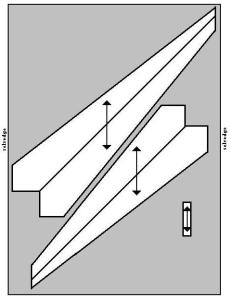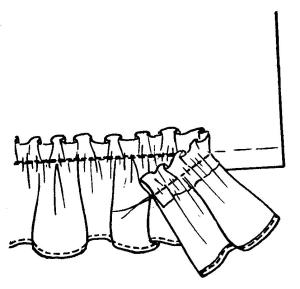 Featured: Silk ties by Terrence Dobbs
Featured: Silk ties by Terrence Dobbs
Make Dad your own specially-designed tie for Father’s Day.
Fresh from the Hamptons, Terrence Dobbs will inspire you with his ‘Father & Son’ ties.
You will need:
- 1 square yard [meter] of fashion fabric (try something silky)
- coordinating thread
- kraft paper
THE NECKTIE PATTERN
This tie is drafted by height.
The four major parts of the necktie draft equation are the length of the tie from the big tip to the knot, the knot itself, the tie around the neck, and finally the tail end of the tie that is hidden behind the front of the tie. The length should be reasonable so that when one tip is touching the belt buckle, the other tip can be securely held in place in the carrier on the back side.
Height = measure vertically from top of head to heels.
Neck measurement = measure around base of neck.
Tie Width = 3.5 – 4 inches [9-10 cm] (it can vary on current fashion)
Tie Knot = 5 inch allowance [12.5 cm] (Half-Windsor type)
Take a length of kraft paper and fold it lengthwise. (You may glue 2 pieces together if needed).
Along the fold, plot the following:
 A-B = 0.30 of the height
A-B = 0.30 of the height
B-C = neck measurement + ½” [12mm]
C-D = knot allowance
D-E = 0.30 of the height – 3” [75mm]
Square 90° across from foldline at all points.
F-C = 0.75 of tie width
G-C = C-F
Join F and G with a straight line.
H is mid-point of F-G.
I-C = C-D
J-I = C-F
K-A = tie width; square up.
L-K = K-A
M-L = K-A
Join M to J with a straight line.
Join L to H with a straight line.
Using a set square placed on line L-H, square a line from A to locate N on line M-J.
Join L-A and L-N with a straight line.
O-E = 0.50 of the tie width
O-P = E-O
P-Q = E-O
Join Q and F with a straight line.
Join P and H with a straight line.
Using a set square placed on line P-H, square a line from E to locate R on line Q-F.
Join P-E and P-R with a straight line.
Join F to J with a straight line.
At B and D, draw a 1” x 1” square [25mm X 25mm] with one of its sides positioned on the foldline.
Add 3/8” [1cm] seam allowance around the perimeter of the tie pattern.
 Cut out the tie pattern and open the folded paper.
Cut out the tie pattern and open the folded paper.
Extend line F-G across the pattern piece. Cut through line F-G.
Draw a grainline through opposite corners of the square box at B and D.
CUTTING
 Cut 1X self for upper portion of tie.
Cut 1X self for upper portion of tie.
Cut 1X self for under portion of tie.
Cut 1X self for carrier – 6” X 2 ½” [150 mm X 65mm]
Tip: A rotary cutter is ideal for cutting fabric on bias grain.
ASSEMBLY
1. Make a carrier loop 6 inches by 1 ½ inches [150mm X 40mm].
2. With right sides facing, align and match upper and under portions of tie together at center seam. Pin/baste and stitch seam using a ¼” [5mm] seam allowance. Press seam open.
3. With right sides facing, align and match each tie end along raw edges. Pin/baste and sew each tie point using a 3/8” [1cm] seam allowance. Press seam open. Grade and trim points. Turn tie right side out.
Tip: A wooden chopstick lets you get into tight corners when pressing a seam open.
4. Fold the tie fabric with wrong sides together; align and match raw edges along length of tie. Baste both layers together.
This tie is self-lined. Select which side of the tie will be the face side.
5. Fold the tie carrier in half to form a loop and secure it 10” [25.5cm] from the front tip on the face side of the tie. Sew it to the seam allowance.
6. With the tie face down, fold the basted raw edge 3/8” [1cm] over the center of the tie along its length. Herringbone stitch along the raw edge catching only the top layers of fabric.
Tip: Use waxed thread and a new needle whenever doing hand-stitching.
7. Place the folded edge over the basted raw edges and align to center (careful not to stretch fabric). Slipstitch along folded edge, catching only the top layer of fabric to complete the tie.
8. Without touching the fabric, gently steam the tie shape. Let fabric cool before handling. (Do not press the tie.)
 Courtesy: Vogue
Courtesy: Vogue This pattern is drafted
This pattern is drafted  Dress Back – cut 1X self on fold
Dress Back – cut 1X self on fold Turn upper edge of dress down 1 inch to make a gathered ruffle, and baste. Apply the bias fold tape on top of the raw edge of the turned dress edge. At this time, place one shoulder strap under the top edge of the bias fold tape and locate it in the middle of the front pieces. Make a
Turn upper edge of dress down 1 inch to make a gathered ruffle, and baste. Apply the bias fold tape on top of the raw edge of the turned dress edge. At this time, place one shoulder strap under the top edge of the bias fold tape and locate it in the middle of the front pieces. Make a  On the bottom of the dress, apply the flounce to the bottom edge.
On the bottom of the dress, apply the flounce to the bottom edge.  Featured: Rouge Passion Capelet by Giambattista Valli for Moncler.
Featured: Rouge Passion Capelet by Giambattista Valli for Moncler.
 Use a set-square to draw a 90 degree angle on the Kraft paper.
Use a set-square to draw a 90 degree angle on the Kraft paper.
 Back and Sleeve Insulation – cut 1X batting
Back and Sleeve Insulation – cut 1X batting
